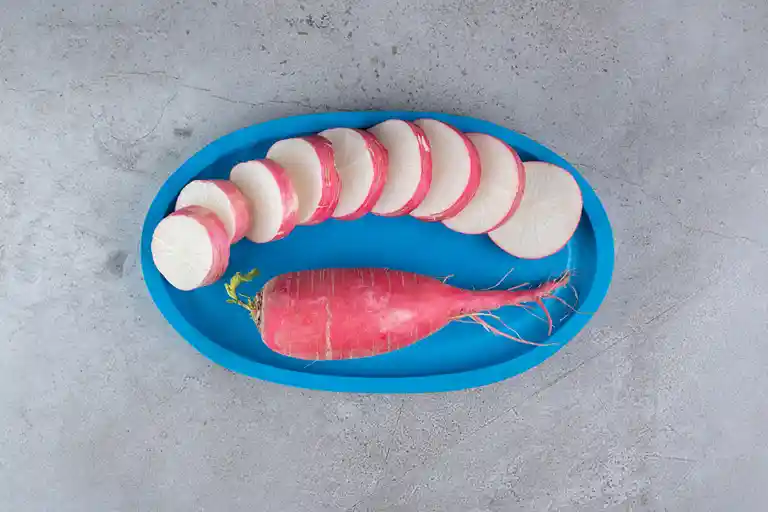What Makes The Difference Between Korean Radish and Daikon
When it comes to radishes in your kitchen, you might have come across Korean Radish vs Daikon. They might look similar, but they each bring their own unique flavors and textures to the table. Let’s take a closer look at what sets these radishes apart.
Korean Radish vs Daikon
| Korean Radish | Daikon | |
|---|---|---|
| Flavor Profile | Mildly sweet with a gentle flavor | Slightly spicy, featuring both bitterness and pepperiness |
| Texture | Crisp and crunchy | Soft and tender |
| Culinary Uses | Ideal for soups, stews, stir-fries, pickled or fermented dishes | Perfect for salads, slaws, soups, stews, and even tempura |
| Nutritional Value | Rich in vitamin C, low in calories, and a good source of fiber | High in calcium, low in calories, and rich in dietary fiber |
| Availability | Might be challenging to find beyond Korean markets | Widely accessible in supermarkets and various Asian markets |
| Price | Tends to be pricier due to limited availability | Generally more budget-friendly than Korean radish |
How They Look and What They’re Called
Korean Radish: The Plump White One
Korean Radish, also known as “Mu” in Korean cuisine, is chubby and white on the outside. Its smooth skin hides a crisp and juicy inside. Shaped like a chubby log, it’s a staple in Korean dishes.
Daikon: The Long and Mild One

Daikon, which gets its name from Japanese words meaning “large root,” is longer and has a milder flavor. Its pale green or white skin covers a softer flesh that’s less dense than Korean Radish. It’s a popular ingredient in Japanese cooking.
Flavors that Make a Difference
Korean Radish: Sweet with a Touch of Spice
Korean Radish has a unique mix of mild spiciness and sweetness. This mix adds a special touch to dishes. The gentle spiciness goes well with the sweet undertones, making it a balanced choice.
Daikon: A Blank Canvas for Flavors
Daikon has a milder taste, but what makes it special is its ability to soak up flavors. This makes it great for soups and stews, where it takes on the delicious tastes around it without overpowering them.

How They Feel and What to Cook
Korean Radish: Crunchy and Versatile
Imagine a crunchy and juicy bite – that’s Korean Radish. It stays crunchy even after being pickled or cooked. This makes it perfect for salads and stir-fries. It adds a refreshing twist to your dishes.
Daikon: Soft and Flavorful
Daikon’s texture is soft and its taste easily absorbs other flavors. This makes it a go-to for stews and soups. It soaks up the deliciousness around it, making every bite full of flavor.
How to Use Them in the Kitchen: Korean Radish vs Daikon
Korean Radish: Crunch for Days
Korean Radish’s crunchiness and gentle sweetness make it perfect for all sorts of dishes. Try it in salads for that extra crunch or in stir-fries for a burst of flavor. If you’re into pickles, it’s a must-try.
Daikon: The Flavour Enhancer
Daikon’s mild taste is its secret weapon. It enhances dishes like Miso Soup and Oden, where it soaks up the flavors, making every bite delicious. It’s a subtle way to level up your cooking.
What Makes Korean Radish vs Daikon Special

Korean Radish: The Crunchy Star
Korean Radish stands out for its unbeatable crunchiness, even after cooking. Its sweet and spicy taste adds a unique twist to your meals, making them memorable.
Daikon: The Flavor Sponge
Daikon’s standout feature is its ability to absorb flavors like a sponge. It becomes a part of the dish, elevating the taste without stealing the show.
Korean Radish vs Daikon: How to Use Them
In the Kitchen, with Love
If you’re excited to try Korean Radish, toss it into salads and stir-fries. For Daikon, let it join your soups and stews. Experiment with these radishes to discover their magic in your own recipes.
Korean Radish vs Daikon: Remember
Korean Radish and Daikon might be from the same radish family, but they have their own unique personalities. Korean Radish brings the crunch and a sweet kick, while Daikon soaks up flavors like a pro. Whether it’s Korean or Japanese cuisine, these radishes have got you covered. Embrace their differences, get creative, and make your meals truly special.



